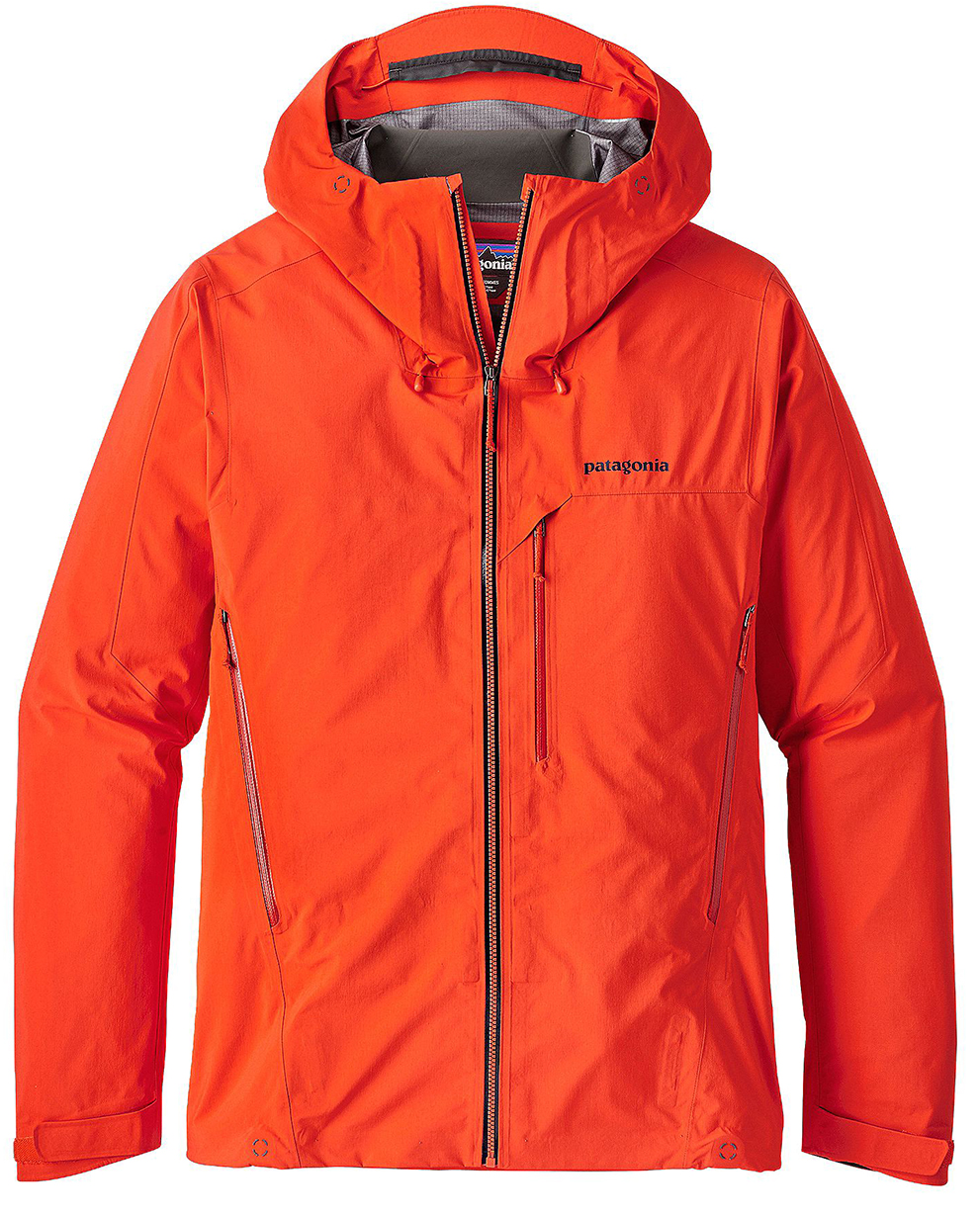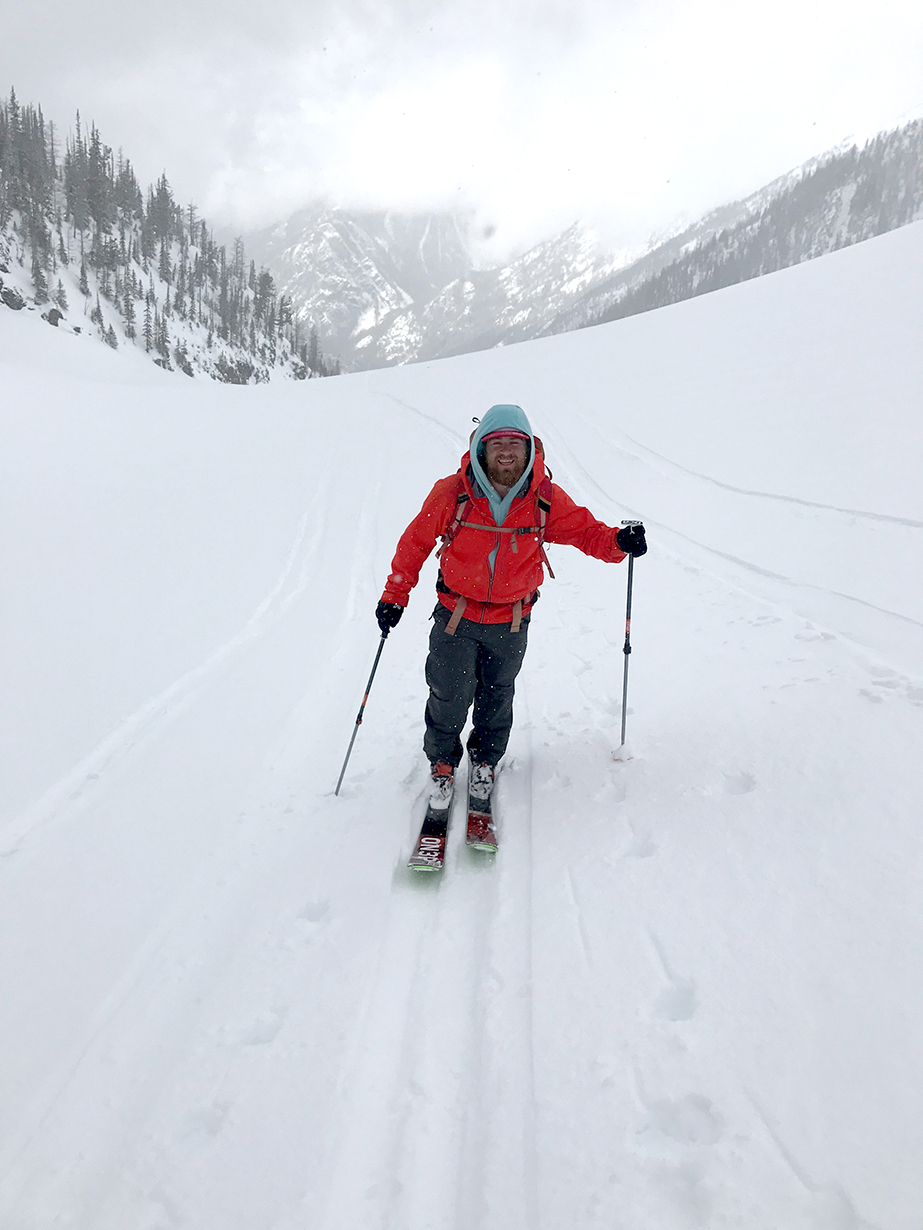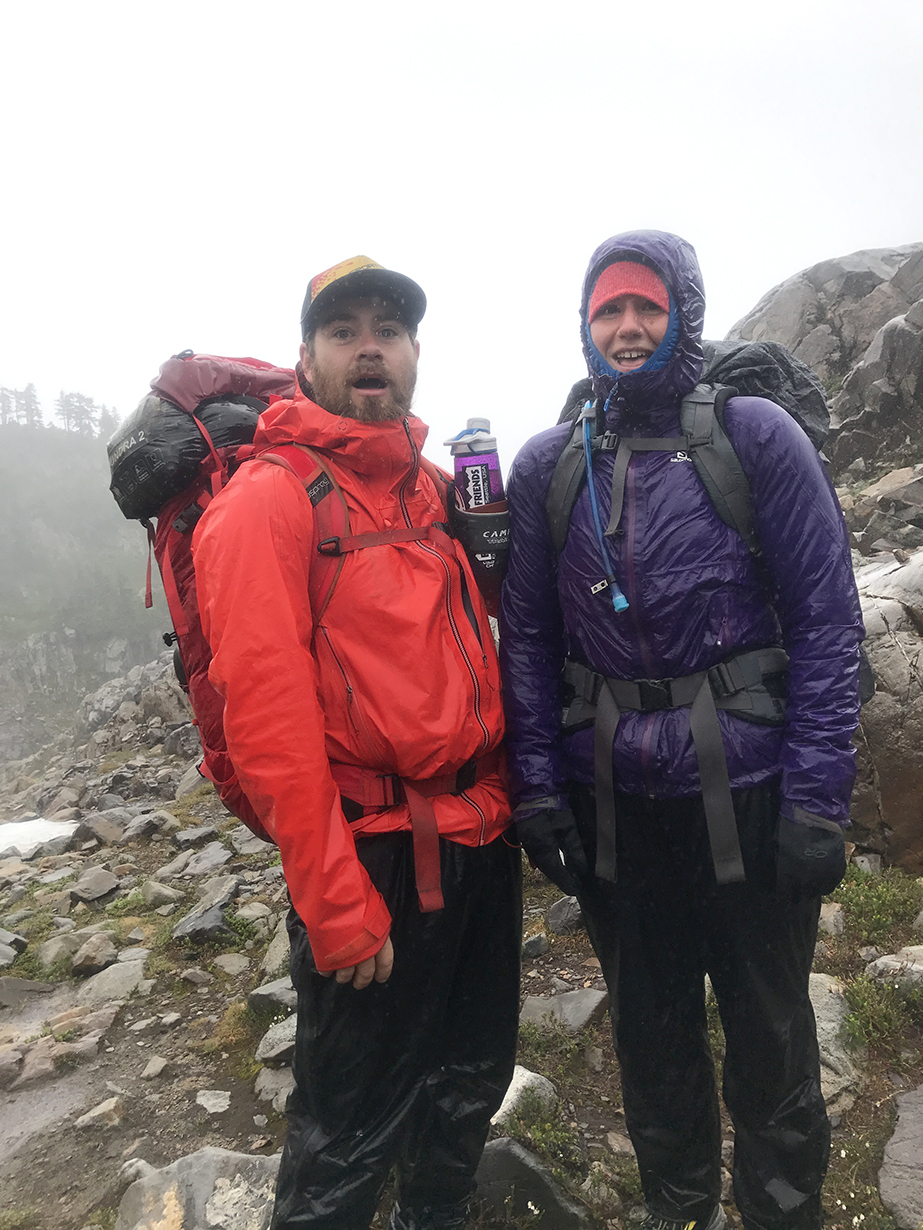
Patagonia Pluma Jacket
Reviewer: 5’8”, 195 lbs
Size Tested: Large
Measured Weight: 429 g (15.1 oz)
Fabric: 40-denier 100% recycled nylon Gore-Tex Pro
Stated Features:
- The 3-layer GORE-TEX® PRO fabric featuring GORE® Micro Grid Backer Technology combines superior waterproof/breathable performance in a lightweight yet durable fabric.
- Minimal seams are reinforced with narrow seam tape for low bulk.
- Hood adjusts with single-pull Cohaesive® embedded cord-lock system to work equally well with any type of helmet or a bare head.
- Watertight, 2-way pit zips for venting.
- Cohaesive® embedded cord-lock system has two contact points at hem for intuitive, one-handed operation.
- Cuff features minimal self-fabric hook-and-loop cuff closure and textured polyurethane inner cuff that grips gloves, sealing out the elements
Pockets:
- Two zippered, pack / harness-compatible handwarmer pockets
- One zippered exterior left-chest pocket
- One zippered interior right-chest pocket
MSRP: $549
Test Locations: Revelstoke Mountain Resort & Boulder Hut, British Columbia; Glacier National Park, Downing Mountain Lodge, Whitefish Mountain Resort, Lookout Pass, Missoula, & Northwest Region Backcountry, Montana; Mt. Hood, OR; Mt. Baker, WA
Days Tested: 35
Intro
Though soft shells have been getting better and better and are great for most high-output activities, serioius storm days and seasons of intermittent precip still require the increased protection of waterproof hard shells. And for those days, Patagonia offers the new Pluma, which is their take on an all-around Gore-Tex Pro jacket. The Pluma comes in at a respectably low weight, and has the features to potentially make it a versatile piece. So, I took the Pluma with me while touring, climbing, and biking in order to see exactly where this jacket excels, and how it compares to some of the other options on the market.
Fit
Patagonia says the Pluma uses their “Regular” fit, and I’d say the size Large I tested feels similar to other “Regular” Patagonia jackets I’ve used. It’s a bit baggier than comparable fits from both Outdoor Research and Mountain Equipment.
Spandex seekers should look elsewhere. The Pluma has lots of room to move around in, and plenty of space for layers beneath the shell. The cut hits a bit below my waist to the point that it won’t ride up past the hipbelt of my pack — a big pet peeve of mine while skinning or riding lifts.
Fabric
The Pluma’s fabric is perhaps the most important feature on the jacket. 40-denier Gore-Tex Pro strikes a nice balance between durability and suppleness. The fabric didn’t tear when smashing into tree branches while I was hurtling through the woods in Canada, yet it’s not quite as crinkly as the 80-denier Gore Pro I’ve used on other jackets. That said, the fabric of the Pluma still feels like a traditional hard shell, and is noticeably less supple than fabrics like Gore-Tex C-Knit, Polartec NeoShell, or Outdoor Research’s Ascentshell.

On the inside, the Pluma uses Gore’s Micro Grid Backer, which they describe as “a thin, low-denier, low-density woven fabric backer … that allows the garment to slide easily over internal layers.” I found that to be very true. Even when only layered over a short-sleeve shirt around town, there’s no clammy feeling in this coat.
Weight and Packed Size
At a measured weight (size Large) of 429 g / 15.1 oz, the Pluma is pretty light, especially for a Gore-Tex Pro jacket with four pockets, pit zips, and a fairly generous cut.
Compared to the competition, the Pluma is on the lighter side in terms of weight. The Arc’teryx Beta AR uses a fairly similar Gore-Tex Pro fabric and pocket layout, and checks in at a claimed 460 g / 16 oz. The Pluma saves 164 g / 5.8 oz compared to the Powslayer jacket, Patagonia’s dedicated Gore-Tex Pro ski shell (measured weight of 593 g / 20.9 oz for a Large).
The Pluma also packs down very well. A simple roll and it disappears into a totally manageable size, similar to a sparsely packed Super Burrito. The Pluma does a good job of balancing low weight, small packed size, and useful features. Here, you can have your light jacket, and huge pockets to carry cake in too, plus…
Features
You get a hood that will actually work, with or without a helmet. Both ski helmets and climbing helmets feel just fine under the hood. It works well without a helmet too, and the extra space means more breathing room when pulling it up over a ball cap while skinning. It’s easy to cinch down the hood with both a halo and front drawcords with embedded Cohaesive cord-locks that are sandwiched between the layers of fabric. These embedded cord-locks release with a pinch, never twist out of functional shape, or get frozen solid with rime. Same with the hem drawcords, which are routed into the pockets to keep the cords from dangling and can be adjusted outside or from within the big hand pockets.
Speaking of pockets, there’s a few of them. The external chest pocket is great for keeping your phone handy and the hand pockets easily hold skins for smaller skis (98 at the waist, 174cm) while staying out of the way of pack straps and a harness. Inside, a zippered mesh pocket holds your ID or phone. All of the external pockets are guarded by waterproof zippers.
Details really do make the Pluma stand out. The cuffs close with a tight velcro system that shows no signs of the wear that some shells exhibit right off the bat. The seam tape is thin to save weight and reinforced in high stress areas. The Pluma does not have a powder skirt, which I appreciate, but if that’s a dealbreaker, you should look elsewhere.
Zippers on the Pluma have both pluses and minuses. Kudos to Patagonia for the molded waterproof main zip that will likely be more durable than the coil zips on the pockets and pit zips. Accessing a climbing harness or getting to a beacon could be a lot easier with a lower zipper pull, but the Pluma has a single zip with a metal seat at the bottom, making it easier to get the alignment right every time, but less functional for accessing stuff near the bottom of the jacket. Both pit zippers have become a little more difficult to toggle one-handed as I’ve used the coat, but with finesse they function fine.
Breathability and Water Resistance
Surprising, in a word. Before the Pluma, I’d essentially given up on Gore-Tex for shells that I can skin in. But the most enjoyable aspect of my test of the Pluma was realizing that I could drop the pit zips a bit and chug up the skin track as snow pelted down or the wind picked up. That’s no easy feat on my big frame, especially when moving quickly.
For comparison, the Pluma definitely doesn’t match the breathability of soft shells like Polartec PowerShield Pro or the rapid venting of an eVent membrane. However, in my very unscientific “how sweaty do I get” comparisons, the Gore Pro on the Pluma feels like it’s about 80% as breathable as the eVent shells I’ve used. It’s far, far better than the AscentShell membrane I tested last year.
The waterproofing of the Gore Pro has done an excellent job as well. No wet outs yet, the DWR is still mostly intact, and I’ve not seen any uninvited moisture get through the fabric.

Hard Shell vs Soft Shell
Such that readers might understand my thinking about what kinds of days are appropriate for soft shells versus hard shells, here’s my decision process.
If it’s on lifts, and not springtime, I’m in a Gore Pro hard shell pant for sitting on cold, wet seats. Ditto for my jacket if there’s more than a half-inch of snow forecasted.
For touring, I go soft shell for my pants 99% of the time, unless it’s drizzling or predicted to snow very, very heavily. Jackets are something of a gamble: less than an inch of forecasted precip means I can often get away with a Powershield Pro soft shell like the Patagonia Kniferidge. However, if I’m moving slow with a group, or it looks like it’s gonna snow, I use a hard shell like the Pluma.
Durability
Over the 30+ days I’ve used the Pluma, the face fabric has held up admirably. Only on the shoulders and under my pack straps have I seen the DWR reduced, but never once has the shell wet through, even while ski touring during a day that left ¼” of ice covering my whole car.
The Pluma shows every indication of being the kind of shell that will be able to handle heavy use in my quiver for quite a while.
Who’s it For
The Pluma offers a lighter take on the classic, all-around Gore-Tex shell. Most of my time in the Pluma has been spent skiing and touring, but I’ve also taken it climbing, biking, and stumbling home in a drizzle, and it’s performed well across all these activities. If you want one coat to live in your pack or on a hook by the door regardless of the season, the Pluma is a strong contender.

Folks looking for a stripped-back, more alpinism-focused shell should look elsewhere (the Arc’teryx Alpha FL is worth checking out), and those that want more ski-specific features at a similar weight should take a look at the Arc’teryx Sphene (which Jonathan Ellsworth talks about here). Also, if you know Patagonia’s “Regular” fit is not for you, then don’t expect the Pluma to change your mind.
Bottom Line
The Patagonia Pluma jacket offers reliable weather protection, decent breathability, and useful features, all while coming in at a pretty low weight, making it an especially appealing option for those looking for a hard shell quiver-of-one.

Hey David- Thanks for the review, this is one of the few that covers this jacket and I’m excited blister took a look. I’m currently debating between the patagonia refugitive and pluma for a do everything (resort, tour, bike, camp) jacket as you had described it. I have a question about the size: does patagonia’s “regular fit” for ski apparel transfer over to their more alpine oriented jackets? I have tried on the triolet and descensionist in a medium and both had a longer fit, which I liked. However, based on your pictures it looks like the pluma may be slightly shorter. Like you said, having the jacket ride above the waist straps is incredibly annoying, and being a few inches taller than you I’m nervous about ordering.
Thanks,
Dan
Daniel,
I would say that the Pluma has fit true to Patty’s Regular fit–long enough to stay well below the straps for me. The other Patagonia jackets I own in a Regular fit are on the same length, so that’s a good indication that it should hold true for you.
Cheers,
David